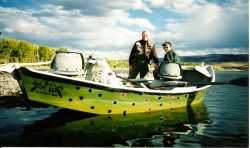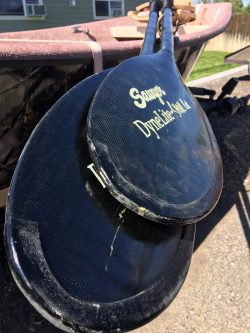 Outfitting a drift boat takes more than a decent set of oars. The entire craft and trailer require attention. The goal is to have a unit that requires little maintenance and is reliable. When we go fishing, we do not want a faulty trailer, broken anchor rope, oar, or any other issues that will diminish our fishing fun.
Outfitting a drift boat takes more than a decent set of oars. The entire craft and trailer require attention. The goal is to have a unit that requires little maintenance and is reliable. When we go fishing, we do not want a faulty trailer, broken anchor rope, oar, or any other issues that will diminish our fishing fun.
Guides must routinely keep their boats, trailers, and gear in perfect shape. The boat needs life vests, first aid kits, permits and licenses, great oars, and a host of other goodies required, or needed, to present their clients with a perfect drift.
Recently it was time for me to buy a new set of oars. My son in law and my daughter Jessie love drifting Montana’s rivers. His old wooden oars were short, aged, and one oar was now in two pieces. My new grandson Clyde will also need to drift and become a Montana Oarsman. Oars would make a perfect addition to our family. Oh, and I would get to use the boat too.
Get ready for sticker shock. The top of the line oars with a mix of wood and composite components, a shoal cut blade, and addons is $800 plus. The oar stops, wraps, and an Oar Rite accessory make the bill higher. Even basic wooden oars with wraps and stops are $500-600. Without oars, the boat is just a lawn ornament.
Oars are what makes the boat go. Without decent oars, the boat is at the mercy of the river. My friend Sean Blaine is the best oarsman I know. He showed me so much about rowing, fishing, and helped me christen my first drift boat. “The newer oars are amazing compared the ones many of us used back in the day. If you ignore the best technology, you are rowing more and fishing less.”
Wooden oars offer some advantages. They float and flex. When the oar is released, it will not sink to the bottom and get shoved back into your face. Composite oars and counterbalanced oars try to mimic this feature, but wood is a great choice. Strengthening the wood oar with Kevlar, vinyl, or composites improves performance.
Using an Oar Rite feature keeps the boat parallel to the current, when anchored. The boat will stay ruddered and stable in the current. This coupling attaches to the oar and slides into the oar lock, to keep the blade perpendicular to the water. Wraps protect and quiet the oar movement in the oar lock. The oar stop also keeps the oar from sliding out of the oar lock.
Anchors are important. You want an anchor that will stop the boat and not drag the bottom. 40 pounds or more is not too much for Montana rivers. The cylinder/ post style anchor works well. A foot release system allows the oarsmen to manipulate the anchor rope without letting go of the oars. A proper thicker rope is easier to pull than a thin one. Never add a knot to the end of your anchor line. You may need to release the anchor and rope in an emergency. The knot will prevent this.
A portable bilge pump is useful. This allows you to keep the water in the river and not sloshing around your floor. Protected full length rod holders are also helpful. Keep a rubber mesh long handled net handy. Comfortable and functional seats are also needed. Use Armor All to protect them from the sun. Floormats or protective floor coatings will dampen noise and protect the bottom from metal boot cleats.
Sean rowed me in the right direction. I ended up buying Sawyer Shoal Blade, Square End wood/composite, oars. Not cheap but they are the best rowing oars available. Montana Jessie will be using the oars and the sales girl at The Barn store, in Bozeman, is an avid oarswoman also named Jessie. My daughters’ husband can also brag and enjoy his new oars.
As you can see, there are a Boatload of things you need to outfit your boat. Do your homework, search YouTube videos, and ask questions of other boaters.
Row, row, row your boat, gently down the stream!
Montana Grant
For more Montana Grant, land him at www.montanagrantfishing.com.